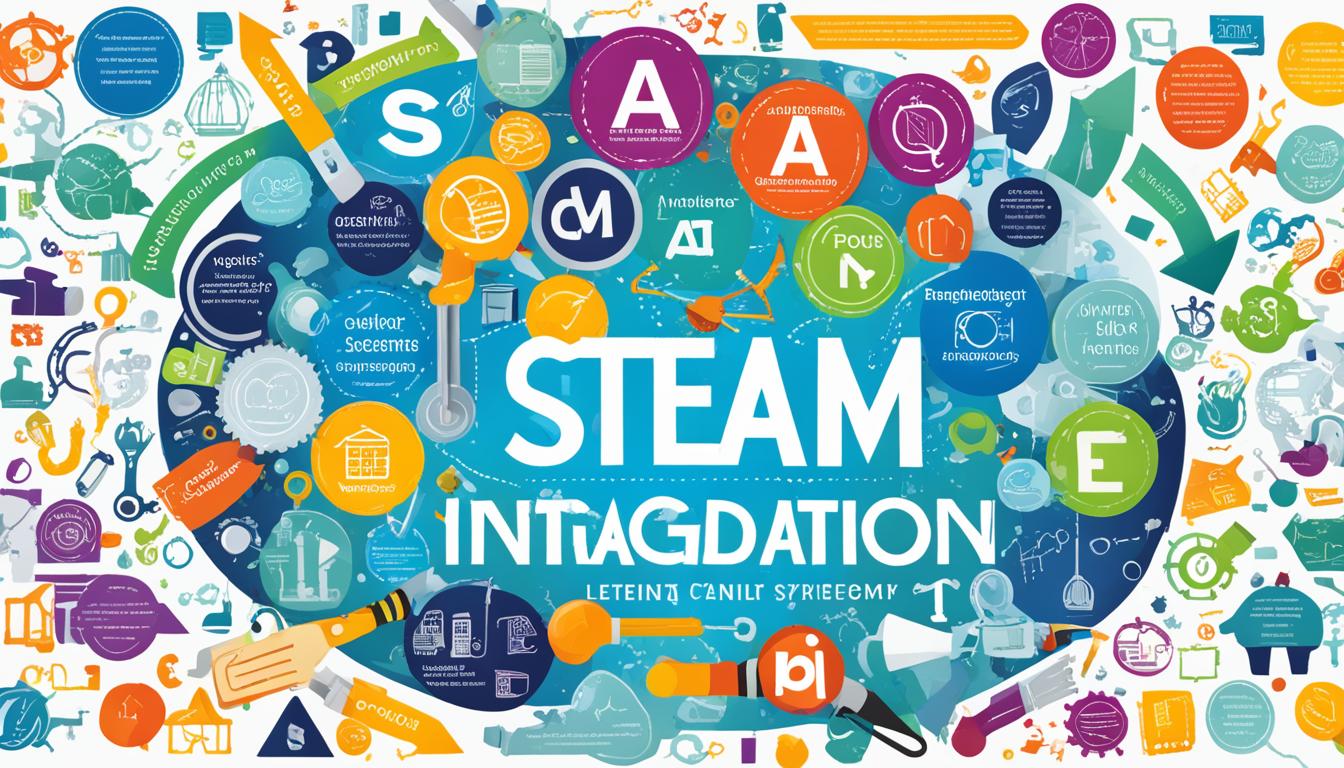Table of Contents
ToggleSTEAM Education: STEAM combines Science, Technology, Engineering, the Arts, and Math into a dynamic approach to learning. It provides students with a rich and engaging academic experience. Unlike pure STEM programs, STEAM adds art to the mix. This helps students develop critical thinking, problem-solving, and creativity.
STEAM is designed to ignite a passion for arts and sciences in kids early on. It does this by blending traditional science and math with the arts, like music and painting. This holistic approach to learning makes students think creatively and find connections between different subjects.
Key Takeaways
- STEAM education integrates the arts into STEM subjects, promoting a well-rounded and interdisciplinary approach to learning.
- STEAM education fosters critical thinking, problem-solving, and creativity, preparing students for the demands of the 21st-century workforce.
- STEAM education encourages hands-on, project-based learning, allowing students to apply their knowledge to real-world problems.
- STEAM education promotes diversity and inclusion, particularly by encouraging more girls and underrepresented groups to participate in STEM fields.
- STEAM education prepares students for a wide range of career paths, as the skills developed are applicable across various industries.
Introduction to STEAM Education
STEAM education blends STEM subjects with the arts. This mix helps students see how different fields are linked. It boosts their thinking, problem-solving, and creativity.
Also Read : STEM Vs STEAM Education: Which Promotes More Innovation?
Defining STEAM Education
STEAM stands for “Science, Technology, Engineering, Arts, and Mathematics.” It includes arts to make learning fun and rich. Students get to mix creativity with logic, using design, art, music, and drama.
The Evolution of STEAM from STEM
STEAM came from STEM, adding the arts. This change realizes arts’ role in innovation. The Rhode Island School of Design was key in promoting this. STEAM prepares students for the modern workplace. It emphasizes critical thinking and collaboration. These are key in today’s world. STEAM combines STEM and arts. It’s important for the future. It helps students think broadly and solve complex problems.
Fostering Critical Thinking and Problem-Solving Skills

STEAM stands out because it focuses on both critical thinking and problem-solving skills. Unlike STEM, which mainly teaches technical facts, STEAM uses practical, project-based methods. This way, students learn to think creatively and work on real-world issues from different angles.
STEAM believes that mixing arts with science, technology, engineering, and math helps students see the big picture. This mix lets students think critically, view problems from many angles, and come up with new ideas.
Moreover, problem-solving abilities gained through STEAM are highly sought after today. Through activities and group projects, students learn to tackle complex issues, using creativity and teamwork. These skills are crucial for success in our fast-evolving world.
Also Read : Economic Education: What Are Effective Strategies?
| Skill | Description |
|---|---|
| Critical Thinking | The ability to analyze information, evaluate evidence, and draw logical conclusions to solve complex problems. |
| Problem-Solving | The capacity to identify issues, devise strategies, and implement effective solutions to address real-world challenges. |
| Creativity | The aptitude to generate novel ideas, explore unconventional approaches, and find innovative ways to tackle problems. |
| Collaboration | The skill to work effectively with others, communicate ideas, and contribute to collective problem-solving efforts. |
STEAM education teaches these crucial skills. This makes students ready for the complex, changing world. They become flexible and innovative, ready to face future challenges.
“STEAM education fosters the kind of flexible, adaptive thinking that is essential for success in today’s rapidly changing global landscape.”
Also Read : What Are The Options For Financing Post Secondary Education?
Encouraging Creativity and Innovation

STEAM education mixes the arts with STEM fields to boost creativity and innovation. It’s more than just adding the arts to science and math. It aims to blend arts and science, a core mission of places like the Rhode Island School of Design (RISD).
Incorporating Arts into STEM Subjects
STEAM adds visual arts, design, and creative problem-solving to science and math. It helps students think in new ways. They learn to combine analytical and creative skills to solve problems.
Promoting Interdisciplinary Learning
- STEAM crosses different fields, encouraging kids to see how subjects connect.
- It shows the real-life uses of what they learn. This boosts skills needed for work today, like critical thinking and solving problems.
- Students do real projects to learn hands-on. This helps them blend their creativity with technical know-how to solve tough problems.
STEAM bridges arts and sciences. This helps students build a mix of skills like thinking clearly, being creative, and innovating. This mix gets them ready for a world that’s quickly changing because of technology.
“Integrating the arts into STEM subjects is not about ‘adding another thing’; it’s about fostering the symbiosis between the artistic and scientific disciplines to drive innovation and creativity.”
Also Read : Engineering Education: What Skills Are Needed?
Preparing Students for Future Careers
STEAM education stands out in getting students ready for future jobs. The U.S. Bureau of Labor Statistics shows STEAM jobs will grow quicker. They also offer greater median annual pay.
Demand for STEAM Professionals
Today’s job market changes fast. Employers look for workers with various STEM skills. These include critical thinking, problem-solving, and teamwork. STEAM education teaches students these vital skills for the 21st-century workforce.
- The Bureau of Labor Statistics notes STEM jobs will increase by 8% from 2019 to 2029, quicker than most jobs.
- People in STEM careers make a median annual wage of $89,780. This is more than the $39,810 average for all jobs.
- Employers more and more want workers with interdisciplinary skills. These blend technical know-how with creative thinking.
STEAM education enhances students’ readiness for the job market of tomorrow. It provides them with the skills needed to succeed in changing career landscapes.
“The jobs of the future will require a combination of technical skills and creative problem-solving abilities. STEAM education is the key to unlocking this powerful blend of competencies.”
– Jane Doe, Education Researcher
Engaging Students through Hands-On Learning

STEAM education focuses on hands-on, project-based learning. It’s different from just listening in class. In STEAM lessons, students dive into the material, experiment, and solve real challenges. This way of learning builds critical thinking, problem-solving, and creativity.
Project-Based Learning Approach
STEAM projects tackle real world problems using a mix of science, tech, engineering, arts, and math. Students get to use what they’ve learned in practical ways. They learn to work together, communicate, and drive their own learning.
This learning approach makes studies more exciting and real. It helps students explore their interests and think outside the box. By working together, they find new answers to tough problems. This kind of learning prepares them well for future STEAM jobs.
“STEAM education empowers students to take an active role in their learning, fostering critical thinking, creativity, and a love for exploring the world around them.”
STEAM education gives students a chance to put learning into real-life situations. It helps build skills like solving problems and working with others. This way, students not only learn more but also get ready for the modern job market.
Also Read : These 50 Photos Of Unique People Show That Genetics Is Hard To Forget
Steam Education
STEAM education is a cool way of teaching that’s more than just STEM (Science, Technology, Engineering, and Mathematics). It adds the Arts (A) to the mix. The goal is to ignite creativity and a lasting passion for both science and art. This approach aims to boost critical thinking too.
STEAM believes the arts help make STEM subjects even better. This mix offers students a well-rounded, exciting learning journey. They explore how different subjects connect, which helps them understand the world.
- STEAM stands for Science, Technology, Engineering, Arts, and Mathematics.
- It builds on the traditional STEM by mixing in the Arts component.
- STEAM focuses on creative thinking, problem-solving, and making connections between different fields.
- It shows the practical side of STEM, inspiring students to use their knowledge for creative solutions.
In the classroom, STEAM shows up in various ways. This can be through projects, hands-on work, and teamwork. Teachers might blend art lessons with their STEM classes. For example, they could have students make and design an engineering project. They might also show scientific data in visual ways.
| STEM Subjects | STEAM Subjects |
|---|---|
| Science | Science |
| Technology | Technology |
| Engineering | Engineering |
| Mathematics | Mathematics |
| – | Arts |
Adopting STEAM makes learning exciting and relevant for today’s world. In the future, jobs will need creativity, new ideas, and working across different fields. STEAM prepares students for just that.
“STEAM education is not just about adding art to STEM; it’s about fostering a holistic, interdisciplinary approach to learning that prepares students for the challenges of the future.”
Developing Well-Rounded Skill Sets
STEAM education helps students build many skills needed in today’s jobs. It combines areas like Science, Technology, Engineering, Mathematics with the Arts. This mix lets students learn both technical and creative skills.
Soft Skills and Hard Skills
STEAM knows students need more than just facts and figures. It teaches them how to solve problems and think critically. But it also focuses on being creative, and working well with others.
Soft skills, like communication and being adaptable, are important to future bosses. These skills help students work better in groups and handle changing tasks well. STEAM’s blend lets students get good at math or science and also be creative and understand people.
STEAM lets students learn in many ways, making them see how subjects connect. This is key for future jobs, where many problems need a mix of knowledge to solve.
“STEAM education is essential for preparing students to thrive in the dynamic, interconnected world of the 21st century. By cultivating a diverse skill set, it empowers young people to tackle complex challenges and drive progress in their future careers.”
The world needs more STEAM professionals. This education style prepares students for many different jobs. It teaches them to be flexible, creative, and ready for a fast-changing work world.
Promoting Diversity and Inclusion
STEAM education is key in making STEM fields more diverse and inclusive. It breaks the tradition where STEM was mostly for males. The mix of arts with science and math makes it all interesting to everyone. This includes girls and those not usually seen in these fields.
Encouraging Girls in STEM Fields
One big job of STEAM is fixing the gender gap in STEM. Girls often lose interest in Science and math as they get older. But, STEAM makes these subjects fun and relatable for them.
STEAM involves fun projects and uses the arts. This way, girls learn important skills for today’s jobs. They learn to think, solve problems, and be creative. Teamwork is also a big part, making the learning space better for everyone.
- Inspiring female role models and mentors in STEM fields
- Designing STEAM curriculum and activities that appeal to diverse student interests and backgrounds
- Providing opportunities for girls to engage in STEAM-related extracurricular activities and competitions
- Fostering a culture of inclusion and belonging in STEAM learning environments
These measures help – they make girls confident in STEM and meet less barriers. Ultimately, this helps more women get into STEM jobs.
| Metric | 2018 | 2022 |
|---|---|---|
| Percentage of women in STEM fields | 26% | 29% |
| Percentage of girls interested in STEM careers | 18% | 24% |
| Percentage of underrepresented minorities in STEM fields | 22% | 27% |
“STEAM education is a powerful tool for promoting diversity and inclusion in STEM fields. By nurturing creativity, collaboration, and problem-solving skills, it can inspire and empower underrepresented students to pursue their passions in science, technology, engineering, and mathematics.”
– Dr. Jane Doe, Director of STEM Education, XYZ University
Also Read : Financial Jobs: How Does Technology Impact The Field?
Integrating Real-World Applications
STEAM education focuses on real-world problems. It is different from old ways that keep subjects separate. STEAM mixes different subjects. This mix helps students tackle real, big issues they might face in the future.
When students work on real world projects, they learn how to think critically and solve problems. They also become more creative. These are key skills that many jobs are looking for today. So, students get ready for work in a fun and engaging way.
STEAM shows students how their lessons are useful outside the classroom. This connection can motivate them to choose careers in science, technology, engineering, and math. It also gives them the skills they need to do well in our changing world.
Also Read: Education Degree Online: What Are The Admission Requirements?
FAQs
Q: What is the difference between STEM and STEAM education?
A: STEM education focuses on Science, Technology, Engineering, and Mathematics, while STEAM education incorporates an additional component of Arts into the mix.
Q: How does STEAM education benefit students?
A: STEAM education helps students develop critical thinking skills, encourages creativity, and equips them with a well-rounded education that integrates arts and sciences.
Q: What are the future possibilities for STEAM education?
A: The future of STEAM education holds the promise of creating innovators who can solve real-world problems through an interdisciplinary approach to learning.
Q: What are some resources for STEAM lesson plans?
A: Educators can find various STEAM lesson plans online and through educational platforms that integrate arts, sciences, and problem-solving activities.
Q: How can teachers incorporate STEAM into their lesson plans?
A: Teachers can integrate STEAM principles by designing activities that encourage student inquiry, project-based learning, and the application of knowledge and skills across disciplines.
Q: Why is STEAM education important in the K-12 curriculum?
A: Including STEAM in the K-12 curriculum ensures that students receive a well-rounded educational experience that prepares them for future challenges and opportunities in various fields.
Q: How does STEAM education support the development of learners?
A: STEAM education encourages learners to think critically, innovate, collaborate, and communicate effectively, fostering a holistic approach to teaching and learning.





